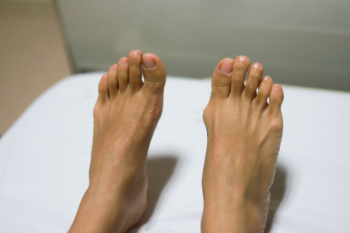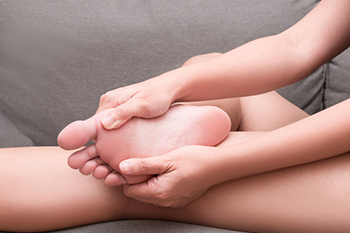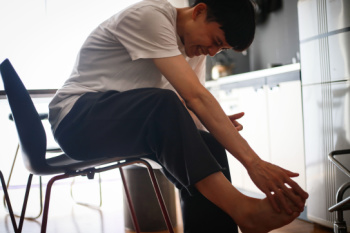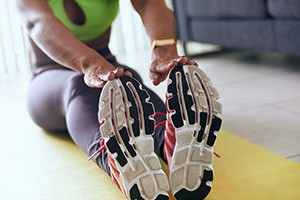
Non-surgical treatments for bunions focus on relieving pain and discomfort, as well as slowing down the progression of the condition. Treatments include wearing comfortable shoes with a wide toe box to reduce pressure on the bunion, using padded inserts or orthotic devices to provide support and cushioning, and resting the foot to reduce swelling and inflammation. Toe spacers or splints may be used to help realign the toes gradually. Stretching and strengthening exercises for the foot and toe muscles can also improve flexibility and stability. While these treatments may not correct the bunion entirely, they can alleviate symptoms and improve quality of life for individuals with bunions who wish to avoid surgery. If you have a bunion that is causing discomfort, it is suggested that you visit a podiatrist regularly to track its progression, and adjust treatment as needed.
If you are suffering from bunion pain, contact Bruce Smit, DPM of Frankfort Foot & Ankle Clinic. Our doctor can provide the care you need to keep you pain-free and on your feet.
What Is a Bunion?
Bunions are painful bony bumps that usually develop on the inside of the foot at the joint of the big toe. As the deformity increases over time, it may become painful to walk and wear shoes. Women are more likely to exacerbate existing bunions since they often wear tight, narrow shoes that shift their toes together. Bunion pain can be relieved by wearing wider shoes with enough room for the toes.
Causes
Symptoms
In order to diagnose your bunion, your podiatrist may ask about your medical history, symptoms, and general health. Your doctor might also order an x-ray to take a closer look at your feet. Nonsurgical treatment options include orthotics, padding, icing, changes in footwear, and medication. If nonsurgical treatments don’t alleviate your bunion pain, surgery may be necessary.
If you have any questions, please feel free to contact our office located in Frankfort, IL . We offer the newest diagnostic and treatment technologies for all your foot care needs.

Sesamoid bones are small, specialized bones embedded within tendons, and play a critical role in the function of the feet. Positioned beneath the first metatarsal head, sesamoid bones provide leverage and support to the big toe, facilitating smooth movement and weight distribution during activities such as walking, running, and jumping. Despite their importance, sesamoid bones are prone to injury and inflammation, a condition known as sesamoiditis. Sesamoiditis typically occurs due to repetitive stress or trauma to the sesamoid bones, commonly seen in athletes engaging in activities that involve high-impact forces on the feet. Improper footwear, excessive pressure on the ball of the foot, and sudden increases in physical activity can also contribute to sesamoiditis. Symptoms of sesamoiditis include localized pain, swelling, and difficulty bearing weight on the affected foot. Recognizing the function of sesamoid bones and understanding the causes of sesamoiditis is essential for preventing and managing this painful condition. If you have any of the above symptoms, it is suggested that you schedule an appointment with a podiatrist who can accurately diagnose and treat sesamoiditis.
Sesamoiditis is an unpleasant foot condition characterized by pain in the balls of the feet. If you think you’re struggling with sesamoiditis, contact Bruce Smit, DPM of Frankfort Foot & Ankle Clinic. Our doctor will treat your condition thoroughly and effectively.
Sesamoiditis
Sesamoiditis is a condition of the foot that affects the ball of the foot. It is more common in younger people than it is in older people. It can also occur with people who have begun a new exercise program, since their bodies are adjusting to the new physical regimen. Pain may also be caused by the inflammation of tendons surrounding the bones. It is important to seek treatment in its early stages because if you ignore the pain, this condition can lead to more serious problems such as severe irritation and bone fractures.
Causes of Sesamoiditis
Treatment for sesamoiditis is non-invasive and simple. Doctors may recommend a strict rest period where the patient forgoes most physical activity. This will help give the patient time to heal their feet through limited activity. For serious cases, it is best to speak with your doctor to determine a treatment option that will help your specific needs.
If you have any questions please feel free to contact our office located in Frankfort, IL . We offer the newest diagnostic and treatment technologies for all your foot and ankle needs.

Gout is caused by the accumulation of uric acid crystals in joints, often affecting the big toe. Gout is notorious for its intense pain, which frequently flares up at night. Although commonly associated with men over 45, gout can develop in anyone at any age. This arthritic condition stems from the body's inability to adequately process purines, which are natural substances found in the body. This inability results in the formation of uric acid. When uric acid levels become elevated, sharp urate crystals form and deposit in joints, leading to inflammation, swelling, and excruciating pain. While the big toe is a frequent target, gout can affect any joint and often strikes suddenly, even disrupting sleep with its severity. Dietary factors play a significant role in gout development, with diets high in red meat, seafood, and fructose-containing beverages increasing the risk. Alcohol consumption and obesity also increase susceptibility to gout. Symptoms can include agonizing pain, swelling, warmth, and redness at the affected joint, which may last up to a week before subsiding. Gout is not curable, but it can be managed with the help of lifestyle and dietary changes and treatment from a podiatrist. If you suffer from the symptoms of gout, it is suggested that you are under the care of a podiatrist who is medically trained to manage this ailment.
Gout is a foot condition that requires certain treatment and care. If you are seeking treatment, contact Bruce Smit, DPM from Frankfort Foot & Ankle Clinic. Our doctor will treat your foot and ankle needs.
What Is Gout?
Gout is a type of arthritis caused by a buildup of uric acid in the bloodstream. It often develops in the foot, especially the big toe area, although it can manifest in other parts of the body as well. Gout can make walking and standing very painful and is especially common in diabetics and the obese.
People typically get gout because of a poor diet. Genetic predisposition is also a factor. The children of parents who have had gout frequently have a chance of developing it themselves.
Gout can easily be identified by redness and inflammation of the big toe and the surrounding areas of the foot. Other symptoms include extreme fatigue, joint pain, and running high fevers. Sometimes corticosteroid drugs can be prescribed to treat gout, but the best way to combat this disease is to get more exercise and eat a better diet.
If you have any questions please feel free to contact our office located in Frankfort, IL . We offer the newest diagnostic and treatment technologies for all your foot and ankle needs.

Embarking on a running journey is a pursuit of both physical fitness and mental well-being. To ensure a sustained and injury-free experience, incorporating preventive measures into your running routine is paramount. A key way to prevent running injuries is to begin with a dynamic warm-up routine, encompassing stretches that target key muscle groups. Consistent strength training that focuses on the core and lower body fortifies the muscles, reducing the risk of overuse injuries in the feet. Investing in quality footwear that suits your foot type and running terrain is a cornerstone of injury prevention. Gradual progression in mileage and intensity allows the body to adapt, minimizing the strain on foot's many muscles and joints. Listening to your body and recognizing early signs of fatigue or discomfort enables timely adjustments to prevent injuries. Post-run stretches that emphasize flexibility aid in muscle recovery and maintain joint suppleness. By integrating these strategies, runners can safeguard against injuries and nurture flexibility, fostering a sustainable and fulfilling running experience. If you are experiencing foot or ankle injuries related to running, it is suggested that you make an appointment with a podiatrist.
All runners should take extra precaution when trying to avoid injury. If you have any concerns about your feet, contact Bruce Smit, DPM of Frankfort Foot & Ankle Clinic. Our doctor will treat your foot and ankle needs.
How to Prevent Running Injuries
There are a lot of mistakes a runner can make prior to a workout that can induce injury. A lot of athletes tend to overstretch before running, instead of saving those workouts for a post-run routine. Deep lunges and hand-to-toe hamstring pulls should be performed after a workout instead of during a warmup. Another common mistake is jumping into an intense routine before your body is physically prepared for it. You should try to ease your way into long-distance running instead of forcing yourself to rush into it.
More Tips for Preventing Injury
If you have any questions, please feel free to contact our office located in Frankfort, IL . We offer the newest diagnostic and treatment technologies for all your foot care needs.